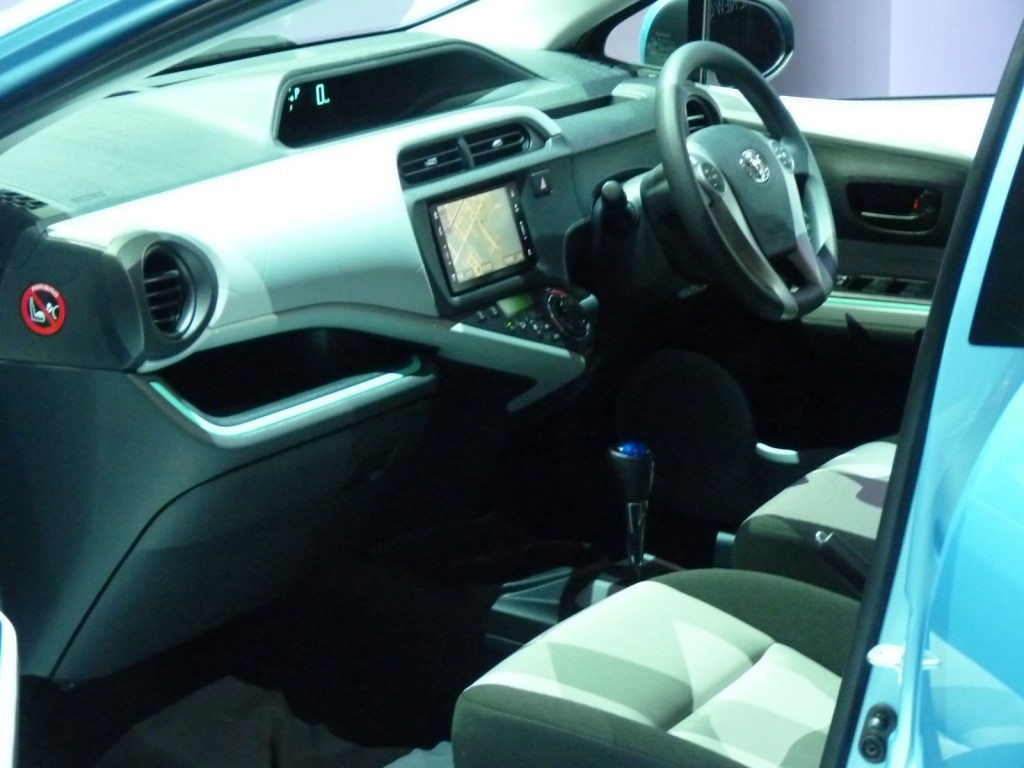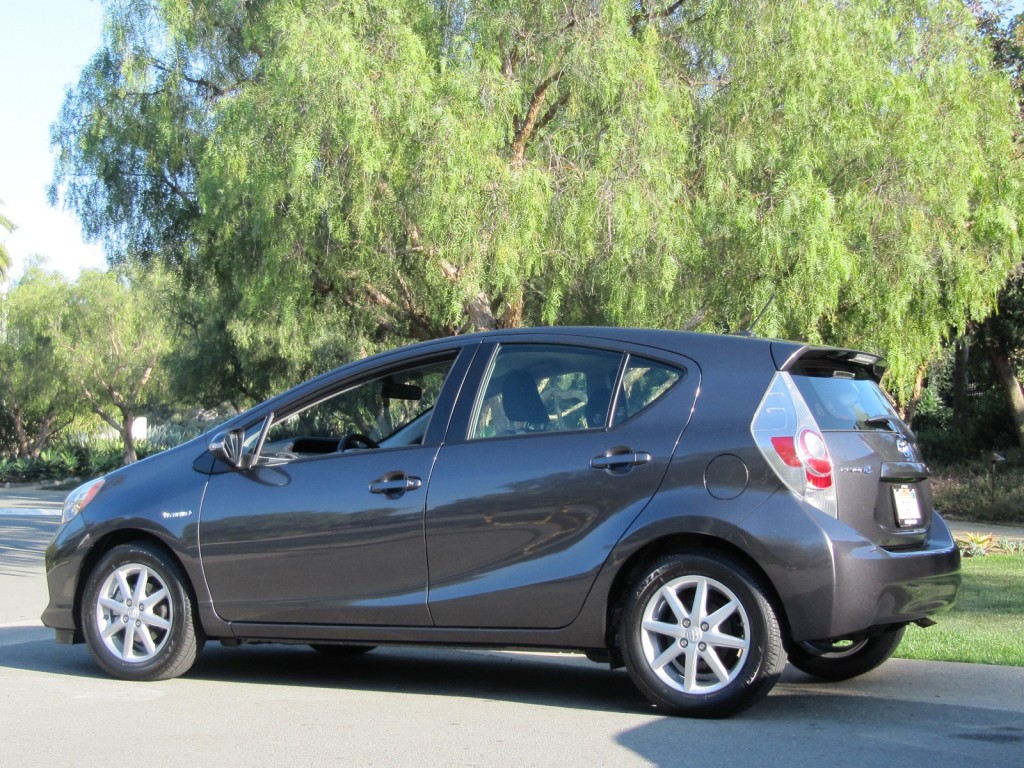The 2012 Toyota Prius C may be the most surprising entry in the expanding Prius range.
It\’s smaller, less unusually styled, and about $5,000 less expensive than the standard Prius liftback.
And it\’s more fun to drive (relatively) than its larger siblings.
It also gets real-world gas mileage of 50 mpg or more; we saw 51.4 miles per gallon over a 50-mile test drive combining San Diego freeways, two-lane roads through rolling hills, and urban stop-and-go.
The EPA rates the 2012 Prius C at 53 mpg city and 46 mpg highway, for the same combined 50-mpg rating as the larger Prius.
Unlike the Prius liftback, which has the interior volume of a mid-size car, the Prius C is a compact car (according to EPA classifications) but Toyota considers it a subcompact in their lineup. Got that?
On the road, almost nimble
Our impressions from two different tests of a base model and a top-of-the-line Prius C Four are that the little Prius is a perfect car for city driving, small and easily maneuvered. It\’s no Lexus at highway speeds, but it\’s not meant to be.
On the road, the low-rolling resistance tires deliver a firm ride that can get busy and jiggly on some surfaces. The Prius C can be noisy at speed, and there\’s more electric motor whine than in other models.
There\’s not a lot of top-end acceleration, and the engine will howl when the accelerator is floored. In this smaller car, though, the effect is less jarring than it is in the larger, quieter Prius models, where the contrast is more startling.
Some Prius design cues, but not all

2012 Toyota Aqua hybrid (2012 Toyota Prius C)
The 2012 Toyota Prius C is a five-door hatchback, like its big brother, but its styling is more conventional. It could almost be an alternate design for the new 2012 Yaris subcompact.
It doesn\’t, for instance, have the split rear window in the liftgate that its much longer sibling does; the rear window is a single pane of glass.
Inside, the 2012 Toyota Prius C has an all-new dashboard that draws its centrally mounted Multi Information Display at the base of the windshield from the larger Prius, and some of its switches and minor controls from the Yaris.
Hard plastic, but well designed
The interior of the Prius C has lots of hard plastics, but their patterns and texturing alleviate the economy-car effect. Front seats are comfortable, and even the rear seat–which sits high over the battery pack and gas tank–will hold 6-foot adults, who have plenty of foot-room under the front seats.
One notable departure from previous Prius models: The \”gear-shift\” lever to put the car into Drive is a conventional chrome lever that sticks up from the console between the seats, rather than the Space Age lever sprouting from the dashboard seen in every other Prius.

2012 Toyota Prius C, drive event, La Jolla, CA, Feb 2012
And, base Prius C One models don\’t have the customary Prius push-button start, but use a conventional ignition key.
Toyota has clearly worked to keep cost down in its smallest hybrid, with painted metal visible inside on the window surrounds and hatchback, but the effect is thrifty rather than grim.
Clever Eco Savings calculator
Toyota has added a very clever feature to the digital information display, one that we think could help sell the Prius C to first-time buyers.
It\’s called the Eco Savings function, and it simply calculates the money you\’ll save on gas costs by driving a Prius C against another vehicle.

2012 Toyota Prius C, drive event, La Jolla, CA, Feb 2012
Users enter the average gas mileage of their current vehicle, along with their local price of gas, and the Eco Savings meter shows how much they\’ll save, in several ways: Cost of gasoline saved over a given distance, savings per mile, or total savings over the actual mileage covered for the current month, the past three months, or the same month of the previous year.
It\’s a good way to help drivers through the challenge of calculating actual fuel-cost savings for a higher-mileage vehicle, and we suspect the feature will make its way into more Prius models in the years to come.
Smaller battery, lower electric range
The 2012 Toyota Prius C uses a 73-horsepower version of the 1.5-liter four-cylinder engine also found in the subcompact Yaris, mated to the company\’s Hybrid Synergy Drive system. Maximum combined output power of the engine and motor-generator is 99 hp.
The engine is completely belt-less, with the air-conditioning compressor and water pump both electrically powered, and Toyota has re-engineered the hybrid system to be 14 percent lighter, more compact, and less expensive to build.

2012 Toyota Prius C, drive event, La Jolla, CA, Feb 2012
It has also reduced the capacity of the nickel-metal-hydride battery pack compared to the larger Prius models. The pack in the Prius C, at 0.9 kilowatt-hours (versus 1.2 kWh for the Prius liftback), is small enough to fit under the rear seat (along with the 9.5-gallon gas tank) rather than below the load deck.
The downside is that all-electric range in the Prius C is reduced to a maximum of about half a mile, versus 1 mile or more in the full-size Prius.
Eco and EV mode, but not Power
Like other models in the lineup, the Prius C offers an Eco mode, which reduces maximum power output and modifies settings on the car\’s climate control to conserve energy.
It also has an \”EV\” setting that keeps it in all-electric mode as long as possible at low speeds, but it does not offer the \”Power\” setting found in its larger Prius siblings.
Toyota has kept the Prius C as light as possible, with a curb weight of 2500 pounds. That helps fuel efficiency, but the car\’s highway mileage is hurt by its short length of 157 inches, or just over 13 feet.

2012 Toyota Prius C, drive event, La Jolla, CA, Feb 2012
Four trim levels
All Prius C models come with power windows and locks, automatic climate control, remote keyless entry, steering-wheel audio controls, USB and Bluetooth controls, a full-color Multi Information Display screen, and nine airbags as standard.
The base model, at a price of $18,950, is the Prius C One. There are four trim levels, all four of which also incur a mandatory $760 delivery charge on top of the price.
The Prius C Two adds cruise control, a 6-way power adjustable driver\’s seat, a 60/40 split folding rear seat, a tilting and telescoping steering wheel, and a six-speaker audio system, and starts at $19,900.
At $21,635, the Prius C Three adds display audio with a navigation system, the steering-wheel Touch Tracer system that lets the driver click through different options in the Multi Information Display, and a smart-key system.
Finally, the top-of-the-line Prius C Four adds 16-inch alloy wheels, heated front seats, and SofTex seat upholstery. It is priced at $23,230.
The only options for the Prius C are alloy wheels and a moonroof.
+++++++++++
Follow GreenCarReports on Facebook and Twitter.












